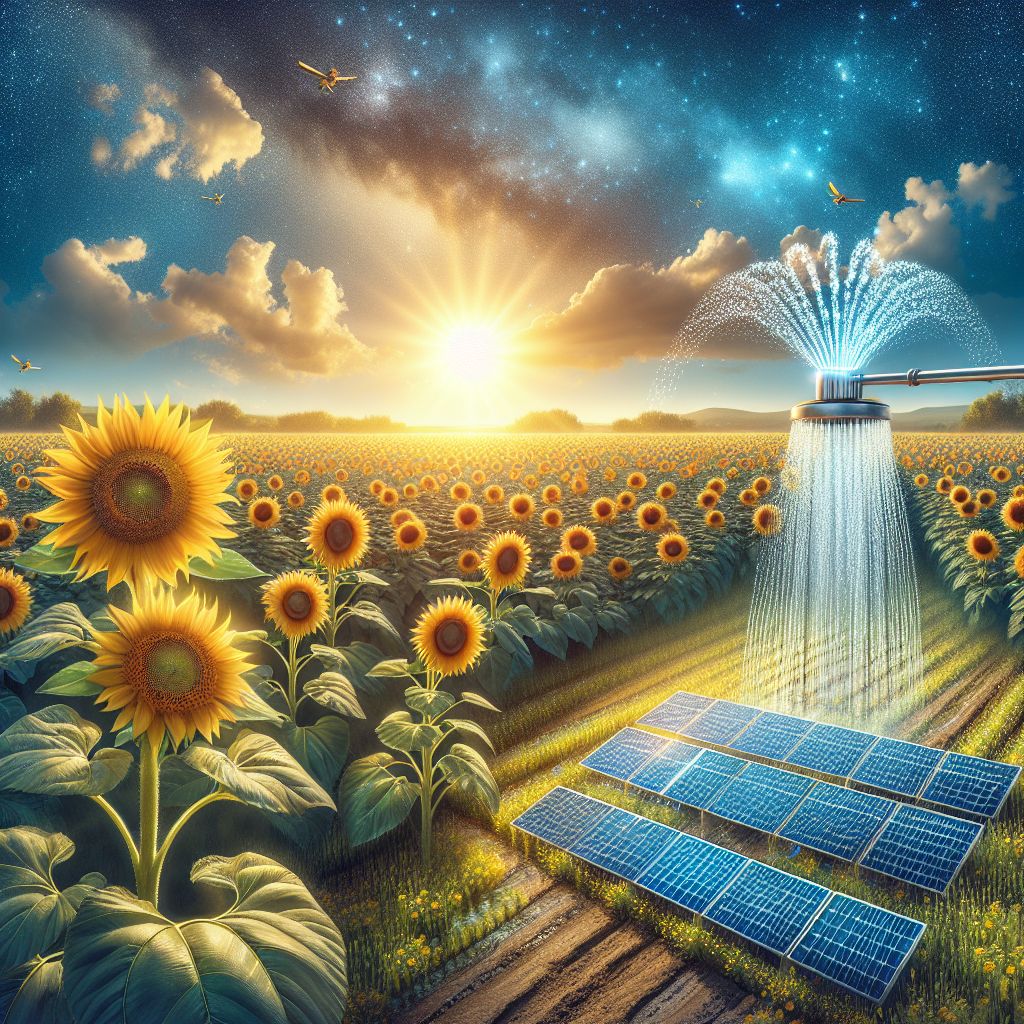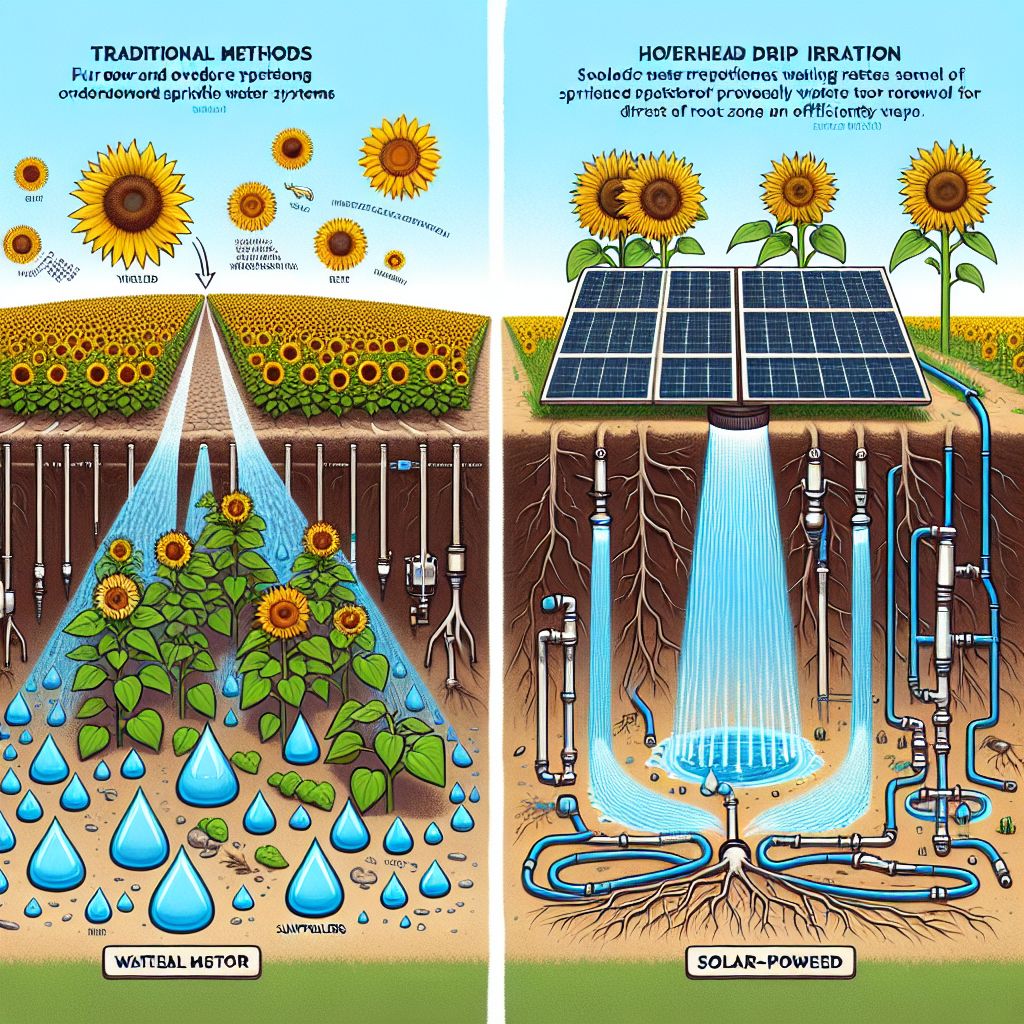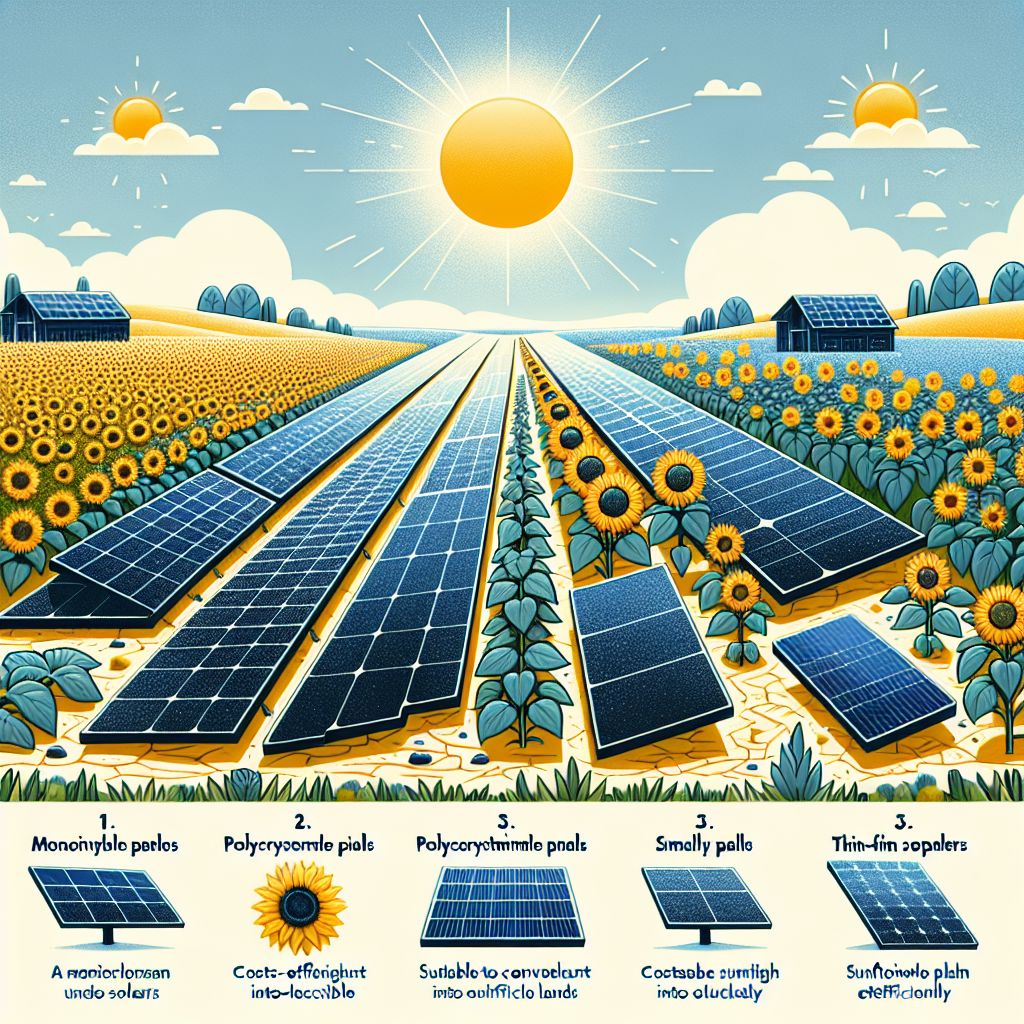
When we think of farming, we often picture large fields of sunflowers, their heads following the sun across the sky. It’s a beautiful image of agriculture working in harmony with nature. But as romantic as this image is, the truth is that farming uses a lot of our planet’s resources, especially water. This is where solar irrigation systems come in, combining the power of the sun with the need for efficient watering solutions. Let’s take a closer look at how these systems are changing the way we grow sunflowers.
Main Points
Solar irrigation systems harness the sun’s energy to power water pumps, thus reducing dependency on non-renewable energy sources.
Drip irrigation, a water-conserving technique, can be combined with solar power for sunflower farming.
Selecting the appropriate solar panel is essential for the efficiency and cost-effectiveness of the irrigation system.
Solar-powered irrigation systems provide environmental advantages and may potentially enhance the yield of sunflower crops.
Considerations for maintenance and initial costs are crucial when shifting to solar irrigation.

Conventional Irrigation Systems for Sunflower Farming
Before delving into the solar options, let’s first understand the conventional methods of watering sunflowers. Sunflowers are usually irrigated using techniques such as furrow or sprinkler systems. While these methods can be effective, they often result in excessive water consumption. On the other hand, drip irrigation supplies water directly to the base of the plant, which can be more efficient and minimize water wastage.
Conventional Watering Techniques for Sunflower Growth
Conventional watering techniques such as furrow and overhead sprinklers have long been the preferred choice for many farmers. They’re well-known and, in some situations, less costly to install. However, they have a major drawback: they can consume more water than is required, and a significant portion of this valuable resource evaporates before it even reaches the plant roots.
Progress in Drip Irrigation Tech for Sunflowers
Let’s discuss drip irrigation. It’s a game-changer. Drip irrigation slowly and directly provides water to the root zone of the plant, where it is most needed. This method can reduce water use by up to 60% compared to traditional methods. And when this system is powered by solar energy, it creates a sustainable cycle that is environmentally friendly and cost-effective over time.
Traditional Irrigation vs. Advanced Irrigation System for Sunflower Growth
There’s no contest when you compare traditional irrigation to advanced systems. Sure, traditional methods will water your sunflowers, but advanced systems like solar-powered drip irrigation take it to the next level. They’re accurate, which means your sunflowers get just the right amount of water, every time.
Why You Should Consider Solar-Powered Irrigation
Why should you choose solar? Well, it’s a form of clean energy. Solar irrigation systems don’t produce greenhouse gases, which is a huge benefit for the environment. They also save you money on your energy bills over time. And perhaps most importantly, they’re dependable. The sun is a consistent source of energy, and with the right system, you can make sure your sunflowers are getting watered even during the hottest parts of the day.
Efficiency Showdown: Traditional versus Solar Irrigation
Efficiency is the name of the game in farming, and solar irrigation systems are taking the lead. Traditional systems just can’t compete with solar in terms of resource efficiency. With solar, the energy is free once you’ve paid for the initial setup, and the water savings from using drip irrigation can be significant.

The Different Solar Panel You Can Add to the Irrigation System for Growing Sunflowers
Solar panels offer a sustainable and cost-effective solution for powering your sunflower irrigation system. By choosing the right type of solar panel and ensuring proper installation and maintenance, you can harness the sun’s energy to nurture your sunflowers and enjoy their vibrant beauty. Embrace the power of solar energy and elevate your sunflower cultivation to new heights. Here are the different types of solar panels you can consider
Monocrystalline Solar Panels: Very Efficient Way to Gro Sunflowers
Monocrystalline solar panels are made from a single, pure silicon crystal. This high-quality silicon gives monocrystalline panels their distinctive dark blue or black appearance. The manufacturing process involves growing a single silicon crystal in a controlled environment, which results in a uniform and defect-free structure.
Monocrystalline solar panels have the highest conversion efficiency among all types of solar panels. They typically achieve efficiencies between 18% and 24%, which means they can convert more sunlight into electricity than other panels. This translates into higher energy production and lower electricity bills.
Monocrystalline panels exhibit excellent performance under various conditions. They handle high temperatures well and maintain stable power output even in low-light conditions, such as on cloudy days or at dawn and dusk. This ensures consistent energy production throughout the day.
Polycrystalline Panels: An Affordable Choice for Sunflower Irrigation
If you’re looking to save money while still benefiting from solar irrigation, polycrystalline panels are a great option. These panels are made from several silicon crystals, making them less costly than monocrystalline panels. While they might not be as efficient in converting energy, they still produce enough power to operate irrigation systems, making them a favourite among sunflower farmers who want to cut costs without compromising efficiency.
Polycrystalline panels are also quite durable, which is essential for withstanding the rigors of farm life. Their resilience to environmental factors means they can reliably power your irrigation system year after year. Besides that, they have a blue hue and a speckled look, which some farmers find aesthetically pleasing amidst the golden sunflower fields.
Opting for polycrystalline panels in your solar irrigation system is a good way to balance efficiency and cost. They work great for large sunflower farms where the number of panels required could make the initial costs of monocrystalline panels too high.
Thin-Film Solar Panels: The Versatile Choice for Different Farming Arrangements
Thin-film solar panels bring a special benefit to sunflower farming – versatility. These panels are light in weight and can be installed on many different surfaces, which means they can be placed in areas that might not be appropriate for standard panels. For sunflower farmers with unusual farm designs or for those who want to use non-fertile land for generating energy, thin-film solar panels are a groundbreaking answer.
Small Sunflower Fields Can Benefit from Portable Solar Panel Systems
If you’re a small-scale sunflower farmer, don’t worry, you’re not left out. Portable solar panel systems are ideal for irrigating smaller fields or for those just getting started with solar irrigation. These systems are not only easy to install, but they’re also easy to move around. This means you can adjust their position to get the most sunlight as the seasons change. What’s more, if you decide to increase the size of your sunflower field, portable systems can be expanded to meet your growing needs. This provides a flexible solution that can adapt to the changing needs of your farm.
Hybrid Solar Panels: The Best of Both Worlds for Dependability
Hybrid solar panels are the newest and most advanced in solar technology, melding the top features of monocrystalline and thin-film panels. These panels are engineered to provide greater efficiency while still remaining flexible and durable. This means that sunflower farmers can depend on a more consistent power source for their irrigation systems, one that performs well under a wide range of environmental conditions.
Here is a table comparing the different types of solar panels that can be used for an irrigation system to grow sunflowers:
|
Solar Panel Type |
Efficiency Range |
Advantages |
Disadvantages |
|---|---|---|---|
|
Monocrystalline |
17-22% |
Highest efficiency, space-saving, long lifespan. 2 | |
|
Polycrystalline |
15-17% |
Lower efficiency, requires more space. 2 | |
|
Thin-Film |
10-13% |
Lightweight, flexible, good temperature coefficient. 2 |
Lowest efficiency, requires large area. 2 |
|
Portable Solar Panel Systems |
Varies based on panel type |
Designed for irrigation needs, easy to move and relocate. 1, 3 | |
|
Hybrid Solar Panels |
Varies based on components |
Can combine solar with other energy sources like wind, increased reliability. 4 |
More complex system, higher cost. 4 |
Monocrystalline panels provide the highest efficiency in a compact area but at a higher upfront cost. 2, 3 Polycrystalline panels offer a balance of efficiency and cost. 2, 3 Thin-film panels have lower efficiency but perform better in high temperatures. 2 Portable solar panel irrigation systems allow flexibility in placement and relocation as needed. 1 Hybrid systems increase reliability by combining solar with other renewable sources but add complexity. 4 The optimal choice depends on factors like available space, budget, local climate conditions, and specific irrigation requirements for the sunflower crop.

Final Thoughts:
We’ve taken a look at a range of solar panel choices for irrigating sunflowers, and it’s apparent that there’s a solution for every farm size and budget. Whether you’re looking at cost-effective polycrystalline panels or flexible thin-film options, the important thing is to select a system that meets your farm’s unique needs and objectives.
However, the benefits of solar irrigation systems extend beyond the panels themselves. Incorporating solar power into irrigation methods is a major stride towards sustainable agriculture. By using the sun’s power, sunflower farmers can reduce their carbon emissions, cut operational costs, and help make the world a healthier place.
For instance, a sunflower farm in California transitioned to a solar-powered drip irrigation system, utilizing polycrystalline panels. In the first year alone, the farm experienced a 30% decrease in water consumption and a 20% boost in sunflower production, proving the efficacy of merging solar power with efficient irrigation methods.
Keep in mind, the upfront cost of solar irrigation might appear intimidating, but the long-term advantages—both financially and environmentally—are significant. With strategic planning and the appropriate configuration, solar irrigation can result in healthier crops, a more sustainable farm, and a more promising future for our world.
The Perks of Using Solar Irrigation for Sunflower Cultivation
Switching to solar irrigation for sunflower farming comes with a whole host of advantages. It’s not just about conserving water; it’s about creating a sustainable ecosystem where every drop of water and every ray of sunlight is used to its maximum capacity. By making the switch, farmers can look forward to higher crop yields, reduced costs, and the peace of mind that comes with knowing they’re farming in a way that’s in sync with the environment.
No matter the size or kind of your farm, there’s a solar panel out there for you. Polycrystalline, monocrystalline, thin-film, and hybrid solar panels can all be customized to meet your needs. The most important thing is to assess your specific situation and choose the technology that provides the best balance of cost, efficiency, and reliability.
Adopting Green Energy Solutions in Farming
Green energy solutions such as solar irrigation aren’t just a fad; they’re a requirement for the future of agriculture. As we confront the problems of global warming and resource exhaustion, it’s critical that we turn to sustainable methods that can guarantee the survival and wellness of our farming efforts.
When you use solar irrigation systems, you’re harnessing the power of technology and the environment to make a real difference. By using these systems for your farming needs, you’re not only setting your sunflower crops up for success, but you’re also playing a part in the bigger picture of a greener, more sustainable future.
Whether you are an experienced sunflower farmer or a beginner, you should think about the numerous advantages of solar irrigation. It is a wise decision for your business, your community, and the world. This is something you should take pride in.
Commonly Asked Questions
What is the Initial Investment for Solar Irrigation Systems?
The initial investment for a solar irrigation system can vary greatly based on the size of your sunflower farm and the type of solar panels you select. Typically, you can plan to invest between $1,000 to $10,000 for a full system that includes solar panels, a pump, and drip irrigation infrastructure. Although the upfront investment may appear high, it’s crucial to take into account the long-term savings on water and energy bills, as well as any potential subsidies or tax incentives for using renewable energy.
What Effect Does Solar Irrigation Have on Sunflower Crop Yields?
By providing consistent and accurate watering, solar irrigation can have a positive effect on sunflower yields. Solar-powered drip irrigation systems deliver water straight to the plant roots, reducing waste and ensuring each sunflower gets the right amount of water. This targeted approach can lead to healthier plants and potentially higher yields than conventional irrigation methods.
Are Solar Panels Resilient Against Severe Weather?
Indeed, contemporary solar panels are constructed to endure severe weather, such as torrential rain, hail, and strong winds. These panels are made with robust materials and are coated for protection to ensure they last a long time. Nevertheless, it’s essential to keep up with maintenance and check your panels frequently to make sure they stay in top shape and function at maximum efficiency.
For instance, a sunflower farm in Texas discovered that their polycrystalline solar panels were still completely operational with only minor aesthetic damage after a brutal hailstorm. This resilience shows the robustness of solar panels in severe weather.
Can Solar Irrigation Be Used for Large Scale Sunflower Farming?
Not only can solar irrigation be used, but it is also highly advantageous for large-scale sunflower farming. The economies of scale that large farms can take advantage of make the cost per unit of energy production lower. Also, solar irrigation systems can cover large areas with the correct design and implementation, ensuring every sunflower gets enough water throughout the growing season.
In Spain, big-time sunflower farmers have successfully put large-scale solar irrigation systems to work, proving that this technology can be both scalable and effective in commercial farming.
How to Maintain Solar Irrigation Systems?
Not much maintenance is needed for solar irrigation systems. You just need to clean the solar panels to get rid of dust and debris, check the connections, and make sure that the pump and irrigation lines are working properly. It’s best to do maintenance checks regularly, at least once every few months, to avoid any problems that could interrupt the irrigation process.
Keep in mind that regular upkeep not only extends the lifespan of your solar irrigation system, but also enhances its performance. This results in improved water management and more robust crops.
In summary, solar irrigation systems provide a sustainable and effective method for watering sunflower crops. By tapping into solar power, farmers can lessen their environmental footprint, save on energy expenses, and possibly boost their crop yield. With proper planning and investment, solar irrigation can revolutionize sunflower farming, leading to a more environmentally friendly approach to agriculture.







Leave a Reply